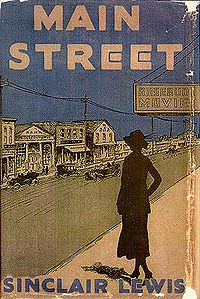- Main Street (novel)
-
Main Street 
1st edition coverAuthor(s) Sinclair Lewis Country United States Language English Genre(s) Novel Publisher Harcourt Brace Publication date 1920 Media type Print (hardback & paperback), and audiobook Pages 448 pages ISBN NA Main Street is a satirical novel written by Sinclair Lewis, and published in 1920.
Contents
Plot summary
Carol Milford is a liberal, free-spirited young woman, reared in the metropolis of Saint Paul, Minnesota. She marries Will Kennicott, a doctor, who is a small-town boy at heart.
When they marry, Will convinces her to live in his home-town of Gopher Prairie, Minnesota (a town modeled on Sauk Centre, Minnesota, the author's birthplace). Carol is appalled at the backwardness of Gopher Prairie. But her disdain for the town's physical ugliness and smug conservatism compels her to reform it.
She speaks with its members about progressive changes, joins women's clubs, distributes literature, and holds parties to liven up Gopher Prairie's inhabitants. Despite her friendly, but ineffective efforts, she is constantly derided by the leading cliques.
She finds comfort and companionship outside her social class. These companions are taken from her one by one.
In her unhappiness, Carol leaves her husband and moves for a time to Washington, D.C., but she eventually returns. Nevertheless, Carol does not feel defeated:
-
- "I do not admit that Main Street is as beautiful as it should be! I do not admit that dish-washing is enough to satisfy all women!"
Literary significance and criticism
Readers' fascination with the portrayal of petty back-stabbers and hypocrites in a small town was probably a factor in the novel's popularity. When the book was published, it was common to wish to live in purportedly "wholesome" small towns like Gopher Prairie; a notion denounced by Main Street's vicious realism and biting humor.
Though it was not expected to be extremely popular, in the first six months of 1921, Main Street sold 250,000 copies, becoming a major best-seller of its time.
Many urban literary critics derided the novel's seeming lack of direction and endless description. Some of Lewis's contemporaries said the novel was too bleak, even humorless, in its conveyance of ignorant small-town life and people.[1] However, Main Street is generally considered to be Lewis's most significant and enduring work, along with its 1922 successor Babbitt.
Some small town residents resented their portrayal and the book was banned in Alexandria, Minnesota.
Because of the popularity acquired by Lewis and his book, high school teams from his hometown of Sauk Centre, Minnesota began to be called the Main Streeters as early as the 1925–26 school year. This name was essentially given to the town by the nearby towns at school events.[2] The Sauk Centre High School still goes by the name in a tribute to Lewis.
Allusions/references to history, geography and culture
The story is set in Gopher Prairie, Minnesota, a fictionalized version of Sauk Centre, Minnesota, Lewis's hometown. The novel takes place in the 1910s, with references to the start of World War I, the United States' entry into the war, and the years following the end of the war, including the start of Prohibition.
With the book published in 1920, Lewis could not have written about the Roaring Twenties or the Great Depression to follow, but his characters give voice to many of the social and cultural attitudes which would become significant in the years to come.
Awards and nominations
Main Street was initially awarded the 1921 Pulitzer Prize for literature, but was rejected by the Board of Trustees, who overturned the jury's decision. The prize went, instead, to Edith Wharton for The Age of Innocence. In 1926 Lewis refused the Pulitzer when he was awarded it for Arrowsmith.
In 1930, Lewis was the first American ever awarded the Nobel Prize for Literature. While a Nobel prize is awarded to the author not the work, and itself does not cite a particular work for which he was chosen, Main Street was Lewis's most well-known work and enormously popular at the time. In the Nobel committee's presentation speech, both Main Street and Arrowsmith were cited.[3] The prize was awarded "...for his vigorous and graphic art of description and his ability to create, with wit and humour, new types of characters."[4]
In 1998, the Modern Library ranked Main Street #68 on its list of the 100 best English-language novels of the 20th century.
See also
- Main street — the iconic street in small town America
Notes
- ^ Anaïs Nin, The Early Diary of, 1982, Harcourt Brace Jovanovich (This author disliked the book herself and cited a review by Cathrin Beach Ely that agreed with her.)
- ^ Gilbert, Rosalind: Our Century: Revisiting Sauk Centre, 2000. p. 77
- ^ "The Nobel Prize in Literature 1930; Sinclair Lewis — Presentation Speech". NobelPrize.org. The Nobel Foundation. 1930-12-10. http://nobelprize.org/nobel_prizes/literature/laureates/1930/press.html. Retrieved 2011-09-12.
- ^ "The Nobel Prize in Literature 1930; Sinclair Lewis". NobelPrize.org. The Nobel Foundation. 1930. http://nobelprize.org/nobel_prizes/literature/laureates/1930/. Retrieved 2011-09-12.
External links
Books by Sinclair Lewis - Hike and the Aeroplane
- Our Mr. Wrenn
- The Job
- The Innocents
- Free Air
- Main Street
- Babbitt
- Arrowsmith
- Mantrap
- Elmer Gantry
- The Man Who Knew Coolidge
- Dodsworth
- Ann Vickers
- Work of Art
- It Can't Happen Here
- Selected Stories
- The Prodigal Parents
- Bethel Merriday
- Gideon Planish
- Cass Timberlane
- Kingsblood Royal
- The God Seeker
- World So Wide
Categories:- 1920 novels
- American satirical novels
- Novels set in Minnesota
- Novels by Sinclair Lewis
-
Wikimedia Foundation. 2010.
